has 13+ years experience in web development, ecommerce, and internet marketing. He has been actively involved in the internet marketing efforts of more then 100 websites in some of the most competitive industries online. John comes up with truly off the wall ideas, and has pioneered some completely unique marketing methods and campaigns. John is active in every single aspect of the work we do: link sourcing, website analytics, conversion optimization, PPC management, CMS, CRM, database management, hosting solutions, site optimization, social media, local search, content marketing. He is our conductor and idea man, and has a reputation of being a brutally honest straight shooter. He has been in the trenches directly and understands what motivates a site owner. His driven personality works to the client's benefit as his passion fuels his desire for your success. His aggressive approach is motivating, his intuition for internet marketing is fine tuned, and his knack for link building is unparalleled. He has been published in books, numerous international trade magazines, featured in the Wall Street Journal, sat on boards of trade associations, and has been a spokesperson for Fortune 100 corporations including MSN, Microsoft, EBay and Amazon at several internet marketing industry events. John is addicted to Peets coffee, loves travel and golf, and is a workaholic except on Sunday during Steelers games.

You have probably noticed that there will be a link on the home page of many websites that is labeled “Sitemap,” as can be seen in the lower right corner of the screen shot. The sitemap is an overview of the structural linkage of a website. While some people used to consider sitemaps as unnecessary to building a website, today having a sitemap is very important for any website. Your sitemap should be placed on your website’s home page. The home page often has the highest PageRank, so by putting the sitemap there, you’ll ensure that your pages get indexed as quickly as possible.

Search engine optimization of your site should be approached from a number of different directions. Sometimes sitemaps are an underestimated tool in your SEO toolbag, but they make things easier on both visitors and search engine robots trying to index your site. When you use your robots.txt file to tell a search engine what pages of your website to exclude when indexing it. The sitemap does the opposite. It tells the search engines where you want them to go.
Sitemaps have been around for awhile. They’ve been part of good web design for years, but now they are even more important due to the adoption of sitemaps by the web-crawling search bots. You should know that while Yahoo! still uses sitemaps in standard html format, Google sitemap uses an XML format that differs from the html sitemap that human visitors use. If you’re worried that having two sitemaps (one in html and one in XML) will be regarded as duplicate content, stop worrying. Google has stated outright that using a sitemap won’t lead to your site being penalized.
SEO is one reason to have a sitemap, and we’ll explore the reasons further in the next section. Other reasons to have a sitemap are for easier navigation within your site, emphasis of the theme of your site, and as “proof” of organization and relevance.
We’ve already talked about sitemaps as a tool in any multifaceted approach to SEO because they can be so helpful to the search engine web crawling robots. Here is how that works. Your sitemap is a page containing links to every page on your site. If a search engine robot hits this page, it will follow every link listed on the sitemap. That means that every page of your site is indexed by search engines. That’s also why a link to your sitemap should show up prominently on the front page of your website. And if your site undergoes changes, sitemaps inform the search engines that they have taken place. The result is that the changes will be indexed faster than if you don’t have a sitemap.
Navigation of your site will be much easier with a sitemap. Have you ever gone to a site and wondered how to find a page without having to poke around endlessly to find it? It’s a great relief to find a sitemap and find a link to exactly the page you were looking for. If you have a very large site, you need to make sure that your visitors can find their way around and back. It’s no fun to find yourself deep within the “shop” section and wanting to get to the “blog” section and not seeing an obvious way to get there. But knowing you can scroll down to the bottom of the page no matter where you are and finding a link to the sitemap makes things infinitely easier.
Sitemaps make it much easier to figure out a website’s theme. Suppose you were searching the web for sites about a certain politician, Mr. X. If you find a site that’s all about Mr. X, you can scroll down to the website and see links to pages within the site on “Great Accomplishments,” “Bio,” and other similar pages. That helps you if you’re a fan of Mr. X, but it also helps you if you can’t stand Mr. X, because you know right away if you want to find another site or stick with the one you are on. Your sitemap gives you the “snapshot” of your site’s theme, so that visitors don’t have to plow through page after page to figure out what your site is all about.
Visitors and search bots aren’t the only ones that sitemaps help. For example, a sitemap lets you, the webmaster have a view of your site’s makeup, and when you add new pages or sections, you can take into account the existing structure just by looking at the sitemap. That way you’ll have a well-organized site, with all the sections sorted out based on relevance.
One advantage of having a sitemap that you submit to the search engines is that you won’t have to rely so much on external links directing the search engines to your website. Sitemaps can also help in the event that you have broken internal links or “orphan” pages that can’t be reached another way. Of course you should fix these problems, but your sitemap can help out temporarily.
For new sites, or sites with lots of new or recently updated pages, using a sitemap can help a lot. Sure, you can go without a sitemap, but they are becoming more standard in terms of submitting websites to search engines. The bots, of course, will continue to index the web, and sitemaps won’t make that procedure go away, but having a sitemap is, if anything, becoming more important to getting your website seen and recognized.
Before you hire an SEO (search engine optimization) company or consultant, or a PPC (pay-per-click) company, you should be thoroughly familiar with what they do.
Hiring an SEO company can potentially raise your site’s profile dramatically in a short time, but if they go about it in the wrong way, you risk damaging your site’s standing in the search engines and your business’s reputation. The general things that SEO companies do include:
Perhaps the best time to hire an SEO company is when you’re launching a new site or redesigning an existing site. When you interview SEO companies that you might consider hiring, ask the following questions:
When choosing a site, make sure you understand exactly where the money is going. There are search engines out there that combine paid results with organic results and some SEOs may promise to get you highly ranked in search engines by placing you in the ad section. These companies are not helpful. Who’s to say they don’t create their own “search engine” that they can easily game or control? You care about the big search engines: Google, Yahoo, Bing, etc.
Some SEO companies will create shadow domains that shunt users to a site deceptively. Suppose you complain about their service. They could easily point your domain to a different site or a competitor’s site. Another bad practice to watch out for is creation of doorway pages stuffed full of keywords on the client’s site, claiming they will make the site “more relevant.” Number one, that’s bull, and two, these doorway pages may well contain links to the SEO’s other clients, diluting the popularity of your site and possible rerouting it to illegal or “bad neighborhood” (“adult”) sites.
Run away from SEOs that own shadow domains, that don’t differentiate between organic search results and paid ads on the results pages, who operate with multiple aliases, or who get traffic from fake search engines.
A great place to start when thinking about hiring an SEO company is Google’s Webmaster Central page where you can download a free SEO starter guide (see screen shot). If you’re going to hire an SEO consultant, you should know what they’re supposed to be doing so you can protect yourself from shady practices.
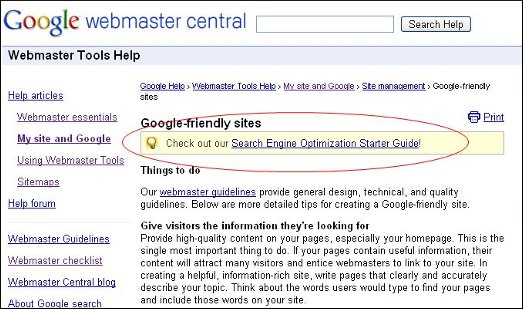
When you choose a PPC company, make sure it doesn’t work for your competitors too. In fact, you should get a guarantee from them that they will not communicate with your competitors when your PPC campaign is in the planning and execution stages. If your PPC company uses unfair means like cloaking to get you a higher rank, fire them at once. They could easily get you penalized or banned by publishers. You should find out what their track record is with top search engines. If their successes come from third-tier engines, look elsewhere for a PPC company. And you should definitely demand references and check up on them.
The reason people hire PPC firms is to give an e-business instant exposure and funnel heavy web traffic to its site. One service provided by PPC advertising firms is landing page optimization. They should also use the marketing techniques that have been proven to increase search engine ranking by honest and acceptable methods. They should increase traffic and conversion rates, and analyze on-site activity as well.
Your PPC company should have a great track record running campaigns on big PPC advertisers like Yahoo and Google. the best PPC companies have a stable of professional PPC experts trained on the most effective SEO techniques so that they can run effective programs for their clients. Their SEO techniques and content should be above reproach. Some PPC companies also offer to redesign sites for SEO, and it is a matter of choice as to whether you want your SEO and PPC coming from the same source. If you do, check and double check references to make sure you’re getting an above-board company.
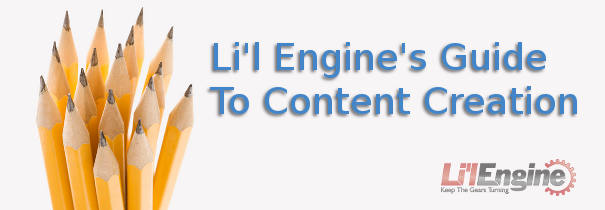
Everything you read about SEO at some point comes back to the same thing: offer great content. You can put every SEO tactic to work at the same time, but if your site doesn’t have great content, it’s like putting Robert DeNiro in a Valentino cocktail dress and Christian Louboutin heels: it’s worth a look, but you’re probably not going to go back to it very often. Whether you write the content in-house or outsource it is really a matter of your staff makeup, your budget, and your preferences.
First of all, people usually don’t “read” on the web. It’s like a glossy magazine. People scan pages looking for images or headlines that appeal to them and often skip past entire blocks of text. Good web content has number of attention-snaggers: the occasional boldface font, headings and subheadings, and plenty of white space around the content. Headings need to be simple and clear. Links must stand out by way of color or underlining, and lists, whether bulleted or numbered, should be used where appropriate. Lists shouldn’t have more than about 10 items, and in general, the shorter the list the better.
The first screen shot is part of a page from Ars Technica (arstechica.com). This is how good web content should be displayed. The title indicates that there will be a list. The graphics are clean and include a helpful screen shot. The headings break up the text into digestible chunks, and there isn’t a bunch of annoying flashy stuff trying to give you a migraine.
Keep in mind that people read screens about one-quarter slower than they do a printed page, and that screen reading is harder on the eyes. Keep the fonts at 10 or 12 point size. Internal links will let your readers jump to the parts of the page they’re interested in. If your external links open in a new window, let your reader know. Some users flip out when they click a link and suddenly windows are opening everywhere. The anchor text to your links should be descriptive. Sure, you’re going to use the occasional “click here,” but try to keep that to a minimum and use anchor text that’s descriptive.
If you’ve written a page that you expect will be printed out for reference purposes or whatever, here are a few points to bear in mind. Keep the links to a minimum for stuff to be printed, since they won’t be clicking them from their paper. If you make a “print version” of a page, indicate in your robots.txt file that the print version shouldn’t be crawled. That will ensure that you don’t get dinged for duplicate content.
On paper, serif fonts are easier to read. Who knows why, but it’s true. Your print pages should be black text, white background, and a minimum of graphics. One of the fastest ways to incur the wrath of a visitor is to give him a print page that will drain all the ink from his printer.
Make sure each page uses its <title> tag properly. The information in these is seen in search engine listings, history listings, and favorites. They’re what other webmasters use as link text when they link to your site. The first word in the title is most important. Think about it: if your visitor has half a dozen tabs open in her browser, the titles of those tabs will get shorter and shorter until they’re just one word long. Since that one word is the first one in your title tag, make it count.
The addendum to this rule is that if you have a large site, make sure each page has a title all its own. Sure, this is a pain and it’s tedious, but your site will perform better in the search engines if you go ahead and do this.
 Your content should start with the conclusion. If you write your pages so that you build up to a whammo conclusion, nobody will read it because they won’t get that far. This isn’t Walden, and you’re not Henry David Thoreau. You want to start out with the big news and then go into the details. The phrase “above the fold” is even more important to web readers than newspaper readers. They’re not likely to scroll down for something unless they’re hooked by the first or second sentence.
Your content should start with the conclusion. If you write your pages so that you build up to a whammo conclusion, nobody will read it because they won’t get that far. This isn’t Walden, and you’re not Henry David Thoreau. You want to start out with the big news and then go into the details. The phrase “above the fold” is even more important to web readers than newspaper readers. They’re not likely to scroll down for something unless they’re hooked by the first or second sentence.
Writing good web content is work, and you may not have the time or inclination to do it. That’s when you consider outsourcing. You already know that your website needs to be updated regularly, and if you don’t have someone on your staff who’s gung-ho to do this (and can be the alloted the necessary work time), then you should consider hiring someone to do it.
If you hire a freelancer or go through an agency, it is important to clearly define an initial job for the writer. Try to be as specific as possible as to tone, topic, length, and how densely keywords or key phrases need to be included. Consider their first assignment a test run and see how well it meshes with your needs. You may want to keep this person on hand regularly because updating your site needs to be regular. It almost doesn’t matter how often you update – though the bigger tech blogs are updated more than once a day – but regular updating is a big plus and it builds up your site’s archive of valuable information while you’re building PageRank and ascending in the search engine rankings.

A landing page is the page that comes up when a potential customer clicks on an advertisement or on a search engine result. The landing page displays content that naturally follows that of the advertisement or the link. It is organized around a few keywords or phrases for search engine indexing purposes. In a pay per (PPC) click campaign the landing is customize to measure how effective different advertisements are so that customers can be more accurately targeted in the future.
Landing page optimization, or LPO is a part of the overall marketing process called conversion rate optimization. The goal of conversion rate optimization is to improve the percentage of visitors that become actual customers and sales leads. There are a number of ways of approaching LPO, some based on targeting, and others based on experimentation:
Open-ended experimentation shows consumers several variations of a landing page and their behavior is then observed. With open-ended experimentation, the landing page is changed dynamically as the results of the experiment change.
Closed-ended experimentation involves the same process as open-ended experimentation, except the consumers’ behavior is monitored. When the experiment is over, an optimal landing page is chosen based on the consumers’ behavior and preferences.
Consumer directed targeting is sometimes known as social targeting. Page content is created based on publicly available information based upon ratings, referrals, reviews, and tagging.
Predictive content targeting is a type of targeting where the page content is changed based on correlating known information about the potential customer (prior purchases and demographics, as examples) in order to anticipate future actions based on predictive analytics.
Associative content targeting is also known as rule-based optimization, or passive targeting. Page content with associative content targeting is modified base upon information gleaned from the visitors search criteria, geographic location, source traffic, or ther generic factors that can be used for non-research-based segmentation of the consumer market.
LPO testing actually goes far beyond this, but it is clear that webmasters put a lot of time and effort into getting their landing page right. While the specifics of a landing page will change based on the industry and the product being offered, there are a few general tips that everyone should keep in mind when it comes to optimizing their site’s landing page.
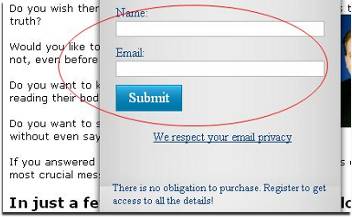 1. Get the registration form right. First of all, know what kind of registration form works best with your particular landing page clientele. The conventional wisdom is that you lose up to one-third of your respondents for each registration field. Whether this is true or not, it is certain that seeing a lot of registration fields is a turn-off to most people, so be sure you’re actually using whatever information you plan to squeeze out of your respondents. Some webmasters think that just getting the email address is best to maximize the number of possible leads, while others think that it’s good to gather a few basic fields of data – enough to be able to separate your A leads from B leads, for example.
1. Get the registration form right. First of all, know what kind of registration form works best with your particular landing page clientele. The conventional wisdom is that you lose up to one-third of your respondents for each registration field. Whether this is true or not, it is certain that seeing a lot of registration fields is a turn-off to most people, so be sure you’re actually using whatever information you plan to squeeze out of your respondents. Some webmasters think that just getting the email address is best to maximize the number of possible leads, while others think that it’s good to gather a few basic fields of data – enough to be able to separate your A leads from B leads, for example.
Put yourself in your landing page user’s shoes. What would he or she think would be sufficient information for you to have from them? Maybe their job title, company, phone number, and potential time frame of purchase would be appropriate, but go much beyond this, and people won’t bother at all. In the first screen shot you can see an example of a very simple registration. While it does appear as a “separate” page covering part of the real landing page, it is simple and it doesn’t float around, following me as I scroll down the page, so it’s pretty reasonable.
2. Don’t overdo the special effects and “wow” graphics of your landing page. Some landing pages make you feel like you’ve landed in the midst of a circus. People don’t have a lot of patience, so it’s better to keep it focused and simple. If your landing page contains a lot of text – and most do – then at least break it up with plenty of subheadings, bullet points and white space. And while you’re at it, offer numerous calls to action. Some people like to click on a call to action button at the top of the page, some will be convinced part of the way through, and others will read through to the last word before responding. Cater to all these people by sprinkling call to action buttons intermittently throughout your landing page. If you’re able, custom tag each link so you can see which ones are used the most. This will help you when it’s time to update your landing page.
3. Make it clear that the customer is in the right place. All it takes is a statement at the top welcoming new subscribers. Users take a little bit of a leap of faith when they click on an ad. It’s nice to know you’ve landed on an actual landing page rather than gone down some virus-laden internet rabbit hole. This leads naturally to the next tip.
4. Don’t do stuff that makes them think their computer has been taken over. Sure, special effects might wow gamers, but a landing page for an e-book on fly-tying doesn’t need the latest special effects. If a landing page is too whiz-bang, visitors may be frustrated close the browser and they’ll never come back.
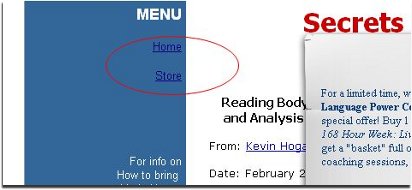 5. Don’t make it too easy for users to escape, however. You may think it’s nice to offer visitors buttons to click for extra information, or to make your landing page fit in better with your other pages (see second screen shot). While it’s OK for your landing page to have some similarities to the rest of your site, you should keep it focused. Your landing page should stand alone, and it’s sole job should be to funnel your visitors to the call to action. The one exception to this should be to offer a link to your privacy policy, but you should put your call to action button there as well.
5. Don’t make it too easy for users to escape, however. You may think it’s nice to offer visitors buttons to click for extra information, or to make your landing page fit in better with your other pages (see second screen shot). While it’s OK for your landing page to have some similarities to the rest of your site, you should keep it focused. Your landing page should stand alone, and it’s sole job should be to funnel your visitors to the call to action. The one exception to this should be to offer a link to your privacy policy, but you should put your call to action button there as well.
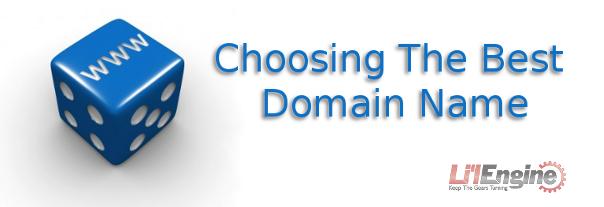
Some people have the idea that the best domain name is the most generic, but that’s not always the case. In most cases, a domain name tied to your brand is better. Think about it. If you’re searching for a certain brand of organic pet food, a domain name matching that brand is going to be more intuitive to you than simply organicpetfood.com (which, as of this writing, is available). The name that you use to advertise your products is almost always the best name for your domain. People who don’t search will try this first in their browser, and if it matches, they’ll almost certainly remember it.

If you’re looking to work your way up the search engine rankings, and who isn’t? Then one way to get some good insights into what works and what doesn’t is to see what your competitors are up to. What does that top ranking site have that your site doesn’t? It is surprisingly easy to find out these things, or some of them at least. One of the great things about the web is that finding who your competitors are is easy, as is comparing services and products. It’s a given that customers usually return to sites that are easy to browse and that have generous amounts of information, even if the visitors don’t partake of all of it.
Once you find out what the top ranking sites in your niche are, what should you do? Well, here are several things you can do.
You can find out some very interesting facts. For example, you might discover that a lot of the inbound links come from websites that the competitor owns. This isn’t always easy to find out, but it’s very informative if you can. The “whois” information may not give you much to go on, but if you do discover that this is the case, you may realize that owning some legitimate websites on the side can help attract more traffic to your site.
You might discover when browsing through your competitor’s site that even though the information on your site is similar, their site has a very different structure – a better optimized structure. It could make a big difference in their search engine ranking. You might discover that your competitor is using a bunch of keywords and key phrases that you never even thought of.
Start off simply enough. Get a pad of paper and a pen and make notes as you thoroughly do your own “crawl” of your competitor’s site. Look over the pages as they appear first, then go back and look at the source html. On most browsers you get this by pressing ctrl+U. If not, this command can often be found in the “Tools” menu of your browser. Don’t worry. You don’t have to be an html genius to learn from it.
Look at their title tag. Is it well written? Does it reflect a common syntax used throughout the site? On the home page, look for the H1, H2, and H3 tags. If you find them, your competitor uses heading tags within the page. Try to identify the actual text used in the headings. You will more than likely find some paydirt key phrases within these tags.
Look for nofollow tags. These are used to spread PageRank throughout the site. Doing this is what’s known as having a themed structure, and it can be very beneficial to your ranking. If you find this pattern, they either know their SEO or they’ve hired someone who does.
How do they do their navigation? Is it in a drop-down menu? Is it search engine friendly? In the footer is there a text menu?
Look at the anchor text: is there a pattern of keywords there? If certain words appear there often, they are almost certainly target phrases.
Check the Google PageRank of the pages you visit. If a page has a notably high PR, pay closer attention to that page. These are often pages that have the information that visitors choose to link to. It could give you some clues for adding similar content to your website.
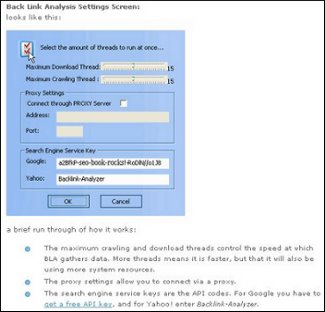 Here’s another cool thing you can do with your competitor’s website: back link analysis. SEO Book offers a free back link analyzer that you can download here. You enter simple information as you can see in the screen shot. When you run the program, set it up to acquire Google Rank and Alexa Rank for each back link. This is a matter of checking two boxes. The back link analyzer automatically filters out “rel=nofollow” links.
Here’s another cool thing you can do with your competitor’s website: back link analysis. SEO Book offers a free back link analyzer that you can download here. You enter simple information as you can see in the screen shot. When you run the program, set it up to acquire Google Rank and Alexa Rank for each back link. This is a matter of checking two boxes. The back link analyzer automatically filters out “rel=nofollow” links.
When you’re done, you can sort your results by PageRank and Alexa Rank. The reason for looking at both Alexa and PageRank is that each has its advantages and disadvantages. PageRank may be quirky due to whatever they’re penalizing recently, so you could miss out on a quality site because of its low PR. Alexa Rank is a measure of popularity, but doesn’t say anything about how Google views its quality. So use both as a system of checks and balances.
If you really want to delve into things, put your report data from the Back link analyzer into a spreadsheet. Make a copy where you sort the data by Google PR from highest to lowest. Then get rid of the ones that rank less than 4. Have another copy where you sort by Alexa Ranking from lowest to highest, and then do another sort by Google PR from highest to lowest. Get rid of the ones that have a negative Alexa Ranking. Congratulations: you now have lists of authority pages that link to your competitor.
So now that you have that data, what do you do with it? If you filter the links by domain, you can see how many links per domain the competitor is getting. If one website is repeated a lot, then you can bet that the competitor owns the website (or has bought a link from them). You can try running a “whois” on the domain, but you may not get a satisfactory answer.
Here’s another thing: if you see that a lot of the links are from the competitor’s own website, then chances are they have good content. If so, take note. You may need to focus on increasing your content or the quality of it.
Next you should figure out which of those links you’d like to get yourself. You can probably get several just by asking. It certainly can’t hurt (unless you accidentally ask for back links from sites that happen to be owned by the competitor, and even then, you might get a link).
In the midst of all this competitor sleuthing, don’t forget about your site. You’re doing this to learn, so be ready to apply some of what you find out to your own site, and hopefully you’ll get a boost in the rankings as well.
OK, let’s be honest right off the bat: most press releases received by most media organizations go right into the recycling bin. But that doesn’t mean yours will. For one thing, the good press releases have a few things in common, and for another, “media” now includes bloggers, ezines, streaming content producers, and freelancers. Whoever you plan to send press releases to, do some research on them first and make sure that your press releases would be a good fit for their organization. It’s the 21st century version of the old “don’t send a dog article to a cat magazine” rule.
 The press release is by no means dead, and is in fact very useful in many situations. Your press releases should be sent to news media for the purpose of letting the world know about company developments and newsworthy items. Concentrate on the word “newsworthy.” The number one reason journalists toss press releases is because they so often consist of self promotion dressed up to appear newsworthy.
The press release is by no means dead, and is in fact very useful in many situations. Your press releases should be sent to news media for the purpose of letting the world know about company developments and newsworthy items. Concentrate on the word “newsworthy.” The number one reason journalists toss press releases is because they so often consist of self promotion dressed up to appear newsworthy.
So really, the first thing you should ask yourself when you’re thinking about sending a press release is “Should I be sending a press release? Or is this just an exercise in vanity or wishful thinking?” Use the “so what” test, because this is what journalists and publishers do. If your press release says, “XYZ Widgetry, Inc. recently hired Dr. Joan Thingity to be head of their engineering development department,” the first thing the journalist is going to think is, you guessed it, “So what?”
Ah, but if your next sentence tells about how she won a MacArthur genius grant for her work on desktop plasma widgetry (or whatever) and that she was at one time part of NASA’s astronaut corps, then you’ve got an answer for the “So what” question. If your press release cannot answer the “So what” question, then don’t send it. Wait until you have something meaty.
While a successful press release ought to be newsworthy, you may have to make the tie-in to the news yourself. Journalists are busy enough that they’re not going to automatically realize that the release of your new phone app coincides with the latest iPhone release. You’ll have to spell it out.
Here are some ways to make sure that your press release is newsworthy and therefore less likely to be chucked in the recycle bin.
You get the idea.
You may wonder why you should bother at all with press releases, since they have such a high chance of disappearing into the gaping maw that is the editor’s office, never to be seen again. But it’s all a part of your overall marketing strategy. SEO has a place, plain old advertising has a place, and media relations has a place too. Once you do get a press release or two picked up, consider contacting the editor or reporters you have traction with and offer to send them exclusives. If they know that they’re the only game in town getting your press releases, they may just take you up on it. But none of this can happen without first mastering the press release. You’ll get nowhere unless you have correct grammar, spelling, and punctuation, plus the compelling writing necessary to stand out from the rest of the herd.

Fortunately, to have a great website today you don’t have to be an HTML wizard or have mad programming skills. There are plenty of technologies for web design that let you have a dynamic or interactive interface on your web pages. Four of those technologies are Ajax, Flash, PHP, and ASP.
 Ajax is short for asynchronous JavaScript and XML. It is a group of web development techniques that are used to create interactive web apps. Using Ajax, web applications can, for example, retrieve data from the server in the background without changing the display and behavior of the page the user is on. XML is not technically required, and the requests from the servers do not have to be asynchronous.
Ajax is short for asynchronous JavaScript and XML. It is a group of web development techniques that are used to create interactive web apps. Using Ajax, web applications can, for example, retrieve data from the server in the background without changing the display and behavior of the page the user is on. XML is not technically required, and the requests from the servers do not have to be asynchronous.
But it’s the asynchronous aspect of Ajax that people love. In standard web apps, interaction has to happen on a step by step basis in a frustrating game of click and wait. But with Ajax, the JavaScript that’s loaded as the page loads handles data validation and manipulation without a trip to the server and back. While it’s changing the display based on a visitor click, it’s sending data back and forth to the server, but the data transfer doesn’t depend on the customer’s actions. The result: almost total elimination of the slow click-wait cycle.
Ajax uses a combination of HTML and CS for creating and styling information. It is, in short, used so that web pages feel more responsive by exchanging small quantities of data with the server while working in the background, so the web page doesn’t have to be reloaded whenever the user requests a change. This goes a long way to speed up the page and make it more user-friendly. That’s because instead of having entire applications posted back to a server, you can have only a small part of the page update independently of the rest of the page. Bottom line: visitors will hate you if you make it so the page has to reload every time they respond to an on-page interactive component.
 Flash is used to add, well, flash to your website. It isn’t easy to learn to write good animations using Flash, so sometimes developers learn to use Flash and then feel like they have to use it everywhere to justify having spent so much time learning it. But you have to be careful with Flash because there are drawbacks to using it. For one thing, search engines have a hard time crawling websites that heavily use Flash graphics, so it’s hard to rank high with an all-Flash website. So it’s not a good idea to use Flash just because you can.
Flash is used to add, well, flash to your website. It isn’t easy to learn to write good animations using Flash, so sometimes developers learn to use Flash and then feel like they have to use it everywhere to justify having spent so much time learning it. But you have to be careful with Flash because there are drawbacks to using it. For one thing, search engines have a hard time crawling websites that heavily use Flash graphics, so it’s hard to rank high with an all-Flash website. So it’s not a good idea to use Flash just because you can.
Whether using Flash is a good or bad choice depends on what your site is for. Flash is best suited as an animation tool, and it’s supported on almost all the web browsers that people use, so you can be pretty sure that if you build a site with a Flash plugin, visitors will see it as you intended it to be seen. Video is a good Flash application because it doesn’t require a plugin like Windows MediaPlayer, and Flash is good for games, because it has better browser support than Ajax. Also, vector graphics look prettier in Flash, and it allows image replacement for special fonts on a site.
On the other hand, unless Flash is optimized for a site, Flash applications can be big and take a long time to load. Sometimes the entire Flash site has to be loaded before it can even be used. People hate this. And frankly, that little graphical countdown clock is small consolation to those waiting to use a site.
Flash usually disables the browser’s “back” button. That means that if a user clicks it while deep in the bowels of a Flash site, they’re taken to the website they were on before they got to the Flash site. If they want to return to the Flash site, they have to re-navigate back to where they were on the Flash site. Face it: the average web surfer has the attention span of a gnat on crack and probably isn’t going to go to all that trouble twice.
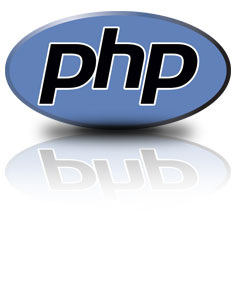 PHP (which stands for hypertext preprocessor) is a scripting language that is open-source so that users have access to the source code and can build, extend, or otherwise customize it for their own use. PHP mostly works as a filter, as it takes input from a stream or a file containing text and / or PHP scripts and outputs another data stream. Usually the output is HTML. While it was originally designed to make dynamic web pages, PHP focuses mainly on server-side scripting now. This is basically a way of making web pages interactive. PHP is also popular in the development of frameworks that provide the structure for rapid application development in which apps are written as they are being planned, making it easier to crank apps out faster.
PHP (which stands for hypertext preprocessor) is a scripting language that is open-source so that users have access to the source code and can build, extend, or otherwise customize it for their own use. PHP mostly works as a filter, as it takes input from a stream or a file containing text and / or PHP scripts and outputs another data stream. Usually the output is HTML. While it was originally designed to make dynamic web pages, PHP focuses mainly on server-side scripting now. This is basically a way of making web pages interactive. PHP is also popular in the development of frameworks that provide the structure for rapid application development in which apps are written as they are being planned, making it easier to crank apps out faster.
There are lots of other technologies for web design besides Ajax, Flash, and PHP, but these are three that are common. If you want to learn the basics of Ajax, go to http://www.learn-ajax-tutorial.com/. To learn more about Flash, go to http://www.w3schools.com/Flash/default.asp. If you’re interested in learning PHP, then try http://devzone.zend.com/article/627. While these are designed to make your site faster and more attractive and fun to visit, they aren’t the whole picture. Without content, the prettiest site in the world isn’t going to keep people coming back.

Just over a year ago, Google made some changes in their algorithm that appeared to be giving weight to “brands.” Now, “brand” is a short word that’s loaded with a lot of meaning. When this change took place, there were plenty of people running around in circles waving their arms in the air thinking that the big, rich corporations were going to dominate the search engine rankings and the whole purpose of organic search would be lost forever (the purpose being bringing users relevant results that could be from anyone, anywhere if they were right on target).
Fortunately, the passage of time has let people make some more considered analyses of that change. To get up to speed, let’s take a quick look at some of the ancient history (dating back to 2003) in search engine technology.

It seems that practically every webmaster understands (or has at least heard) that email marketing is important. The problem is, too many webmasters just stick an email newsletter signup form on their website and figure that they’ve got email marketing taken care of. Nothing could be further from the truth.
An email marketing campaign needs to be carefully planned, setup and optimized for maximum performance. There are many aspects of an email marketing campaign that need your serious attention – opt-ins, messages, deliverability, open rates, etc. This article will just cover one important aspect: email opt-in rate.
In this article, I want to cover three keys to a high opt-in rate that every email marketer should constantly work to improve. (For the purposes of this article, it does not really matter if your campaign is primarily a newsletter or autoresponder.)
The first step to maximize email opt-ins is to offer website visitors a strong value in exchange for subscribing. In most cases, just offering a newsletter is not a strong enough offer – you need something with a much higher perceived value.
One of the best offers is to give a free ebook or whitepaper to subscribers. It does not have to be extensive – oftentimes a 5-10 page ebook that is filled with solid, valuable information will work very well. Make sure that the free gift that you offer subscribers will be appealing and offer value to each segment of traffic that visits your website (or as many of the segments as possible).
An example of a free ebook offer:

(Note how the free ebook in this case is actually relatively promotional in nature. In small, product-focused niches, this strategy often works well. In other markets, you’ll usually need to offer a more educational ebook.)
The opt-in form on your website should be crafted and optimized to convert as many visitors as possible into subscribers. The form should be:
Example of a poor opt-in form:

Examples of strong opt-in forms:

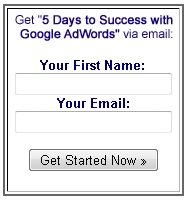
Note: If you aren’t already, you should be requiring subscribers double-opt in. (We’ll just assume that you are for the rest of this article.)
It is essential that you optimize your double opt-in process, since a poorly constructed process can “leak” a substantial number of subscribers. A well-constructed double opt-in process, though, could reasonably get 70-80% of subscribers to complete the opt-in. (While losing 20 to 30% of subscribers may sound bad, realize that a substantial portion of those are probably users who mistyped their email or intentionally submitted an incorrect e-mail.)
Here are several factors you should look at to improve your confirmed opt-in rate:
Summary
Achieving a high email opt-in rate is the starting point for a successful email marketing strategy. Hopefully the tips outlined in this article help you as you continually work to increase your email opt-in rate.
 About The Author
About The Author
Adam J Thompson is Senior Partner at RYP Marketing, providing search engine marketing, conversion rate optimization, and online marketing results to clients around the globe since 2006. You can follow Adam on RYP Marketing’s Facebook page.